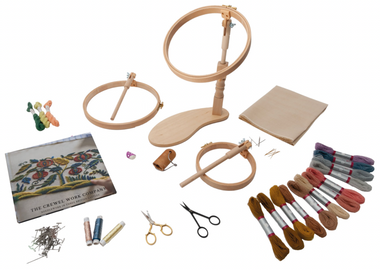I was so excited to see legendary examples of crewel work from the past 400 years that I literally could not sleep the night before my recent trip to the Victoria & Albert's Clothworkers Museum in London. At 3.00am I looked out of my bedroom window and in the incredibly bright full moon witnessed Mikey our cat defending the rockery from a spring toad. I left the next morning for London in full confidence that he would defend the house in the same manner while I was away.
Visiting the collection at the Clothworkers Museum, which is of site at Blythe House, Olympia, takes quite a lot of planning from at least 3 months out. Last time I was there Laura and I took our Lady Anne’s Needlework Retreat to view Elizabethan embroidered clothing including Margaret Layton’s Jacket. I noticed how everyone was both stunned by the beauty and exhausted by the experience of appreciating these exquisite textiles. This time I needed extra energy and concentration to study the crewel work and planned accordingly, making sure I wouldn't be disturbed except by the ping of a WhatsApp message from the office.
After my previous visit, I realised how important it is to make sure that you only ask for items in which you are really interested. Otherwise you can exhaust yourself on beautiful items not destined for your real purpose, which for me is research for my forthcoming book 'A Timeline of Crewel Work'. The V&A have a large collection of crewel work and I have been interested in many of the items for the past 30 years, in particular some items which were photographed in black and white in mid 20th Century books (a time when publishing in colour was prohibitively expensive for the average book). Imagine my excitement at being in the company of these very pieces with hours of study ahead.
I had invited Sarah Thursfield to join me on the first day as there were several items of clothing which needed her expert opinion. Sarah is a known as the author of "The Medieval Tailor's Assistant" and has been researching the history of dress for over 20 years. She is a very experienced stitcher and often lectures during our Lady Anne's Retreats, and is well-known among our regular students for frequently dressing up in historically accurate costume, as she did most flamboyantly in 2016 when we revealed our recreated Lady Anne's Costume (Sarah is seen below to the right of a young 'Lady Anne' wearing the recreated costume (which we are MOST proud of ;) and above Jane Hasell-McCosh, the owner of Dalemain House in Cumbria, which has strong connections to Lady Anne Clifford).

Sarah arrived on the first day absolutely soaked to the skin due to the thunderstorms in London but, as always, kept her spirits up and still managed to be a huge asset when studying the costume. Her first passion is the medieval period, so having her present to discuss these Elizabethan and Jacobean pieces was a huge help.

Our supervisor Connie was just the sort of person who should be caring for such priceless textiles. She kindly equipped me with a trolley for my bits and pieces - laptop, camera, pencil and notebook and reiterated the photography guidelines, which was strangely relaxing since I am usually the one dishing them out to our own students. Tripods are not allowed and professional photographs can be obtained from the V&A for a fee, thus supporting the care of these textiles.

When we received our first piece we could barely contain our excitement. It was an Elizabethan redwork waistcoat. Honestly I would have come all this way for this piece alone. Sarah and I first studied this ‘jacket’ many years ago and I had been dying to see it again. The motifs, the design and the stitches are typical of the second quarter of the 17th Century – Reversed Chain, Seeding, Satin Stitches grouped in 3s, Raised Stem Band, Buttonhole, Crewel Stem/Outline. Sarah thought that the even-weave linen to be around 50 threads to the inch. The embroidery is worked in a very fine red wool thread combined in the needle with a linen thread to produce an unusual speckled effect. The waistcoat is edged in lace, again in linen with red wool inserts. The voluminous sleeves, the expensive red dye, the extra detail of the lace edging all suggested that this was an expensive item, surely the work of a professional studio, and despite the removal of a front panel (possibly to produce a ‘pillowe’ or an insert into a different garment in a different era), this must surely be one of the stars of the collection.
Simply divine.

When I returned home 2 days later I felt the urge to unwrap our own redwork masterpiece, The Altar Frontal, which we will be reproducing as small kits beginning with We Three Kings (top left of the large design), which will enjoy its first outing during my upcoming New Zealand Tour in a few weeks.
I urge anyone with an interest in textiles to visit the Clothworkers Museum. If you are in London and have a spare half day it really is an incredible place to lose yourself for half a day (at least!).
Contact the Clothworker's Museum to book an appointment (when applying to see the items you have to state why you are interested).






